We studied California’s Proposition 47, which became effective in 2014 and reclassified certain theft and drug possession felonies to misdemeanors to reduce state prison overcrowding. Under this policy, individuals with eligible offenses could petition to have their previous felonies reclassified as misdemeanors, with an estimated one million Californians eligible for a record reduction under the law. Since the passage of Proposition 47, many other states, including Alaska, Connecticut, Oklahoma, Rhode Island, and Utah, have adopted measures reclassifying drug possession from a felony to misdemeanor, with policy advocates arguing that these policies can improve outcomes for impacted individuals. The promise of these initiatives has also resulted in the creation of the Clean Slate Initiative to support legislative efforts to expand criminal record remediation and research in this area.
Our analysis uses two unique institutional features of Proposition 47’s implementation in San Joaquin County, California, to identify the causal impacts of this law. First, public defenders initiated the record reductions for tens of thousands of eligible felonies without defendants’ involvement, and the order of reductions was quasi-random for many defendants because the order was determined by the first letter of the defendant’s last name. Second, we implemented an experiment with the San Joaquin County public defender’s office to notify a random subset of individuals who received reductions of their record initiated by the public defender. This gave us the ability to measure the impact of reductions when individuals are fully informed about their record change and thus can attempt to adjust their labor market situation. We assessed the impacts of these interventions on labor market outcomes by linking data on Proposition 47 reductions in San Joaquin County to Internal Revenue Service tax return data.
Past research studying the employment impact of expungement laws has found increased employment after record expungement and has been cited prominently by lawmakers in efforts to pass record-clearing laws. However, this past work relies on voluntary petitions submitted by eligible defendants. This makes identifying the causal effect of expungement more difficult because the individuals who decide to petition for expungement may have characteristics that affect their labor market outcomes and are different from the characteristics of nonpetitioners. Our setting allows us to identify a subset of individuals who, with high likelihood, asked the public defender’s office to file a petition on their behalf. Thus, we can study the potentially different impacts on individuals who (likely) self-initiated the petition process as compared with individuals for whom the public defender filed a petition.
We evaluated the effects of public defender—initiated record reductions by exploiting the quasi-random ordering of reductions to compare employment of individuals before and after their reductions. Our research finds little evidence that employment, self-employment, and tax filing outcomes improve after a public defender—initiated petition reduces a felony conviction to a misdemeanor. Our results allow us to rule out the possibility that record reductions increased employment by more than 3.6 percentage points (10 percent) in the first year after the reduction. However, our results provide evidence of increases in the prevalence of platform gig work (e.g., ridesharing and app-based delivery services) after a felony reduction as well as suggestive evidence of employment increases for individuals with reductions less than four years after conviction.
The results of our experiment to study the impact of notifying defendants about their record reductions also yield null effects. There was no detectable change in employment or other tax-related outcomes for notified individuals when compared with the control group, which received no such notification, implying that lack of awareness is unlikely to be the main driver of the null results.
The results are different for individuals who likely self-initiated their reduction petitions. For this group, our research finds evidence of a 12 percent increase in the probability of having employment in the year of the reduction. However, the evidence suggests that this effect is partly due to characteristics unique to these individuals. In the year prior to reduction, likely petitioners have lower average annual wage earnings than nonpetitioners ($6,003 versus $7,920) and become more likely to be employed even prior to their record reduction, suggesting that petitioners may seek record reductions as part of a broader effort to improve their employment situation. Our estimates of the effect of record reductions on petitioners are similar to those from prior studies, but we can rule out the possibility that these comparatively large effects apply to all defendants using the results from our study of public defender— initiated reductions. These contrasting results highlight the importance of accounting for the bias that can occur when defendants choose whether to petition for record reductions.
NOTE
This research brief is based on Amanda Y. Agan et al., “Labor Market Impacts of Reducing Felony Convictions,” National Bureau of Economic Research Working Paper no. 31773, October 2023.

